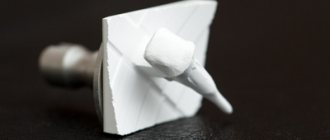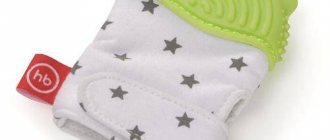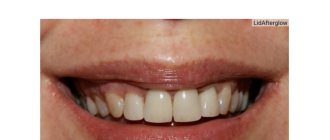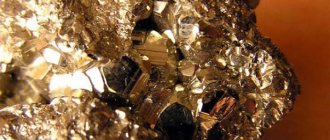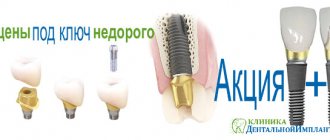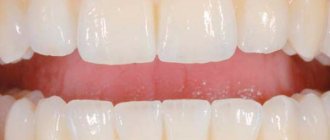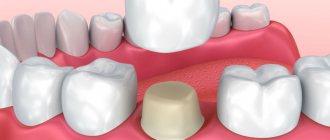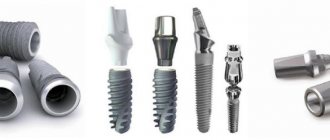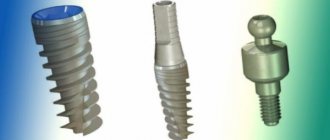Time.
Almost all types of zirconium are sintered in two hours at a temperature of 1450 to 1550 degrees. This rule applies to materials from any manufacturer. According to the standard, sintering takes approximately eight hours, of which the zirconium is gradually heated during three hours, and gradually cooled during the same time. This program is used to create small bridges and single crowns.
For large structures with stabilizers (special supports that prevent the product from deforming during sintering), a long program is used, approximately 18 to 20 hours. The scheme is the same: two hours at peak temperature, and still time for slow heating and cooling. For volumetric structures, rapid sintering is fraught with deformation and the appearance of cracks.
There is also a quick cycle lasting from one to two hours. At the same time, the temperature increases sharply; thirty minutes are allotted to the maximum mode, followed by rapid cooling. To speed up the latter, a smooth opening of the stove is provided. This method cannot be called standard; moreover, it implies restrictions on the length of the structure (up to three units). Added to this is the likelihood of nuances associated with the color and transparency of zirconium.
Selection of oven and heating elements.
The most popular furnaces are furnaces with SiC (silicon carbide) and MoSi2 (molybdenum disilicide) heating elements. In the first case, these are the most budget models, but have a number of disadvantages. These include increased sensitivity at work, intolerance to sudden temperature changes and the inability to speed up the process. If such an oven is opened when it is not completely cooled, cracks may appear or it may become deformed. The operating temperature of SiC is lower than that of MoSi2. In such furnaces, you should also not use acid-based dyes for zirconium.
If you want to avoid technical problems from distracting you from your work, pay attention to stoves with MoSi2 heaters. Their surface is protected by a layer of silicon from oxides formed during heating, which makes the elements more reliable in operation. An additional advantage is that as a result, the color of the material does not suffer during processing.
Recommendation:
During prolonged operation at low temperatures, the silicon layer is quickly destroyed. To restore it, it is recommended to turn on the “cleaning” cycle at maximum heating. MoSi2 furnaces are capable of operating in extreme conditions for fast sintering. To allow the elements to cool faster, the oven door can be opened. IMPORTANT! The fast cycle requires the use of a special cup that can withstand sudden temperature changes. The standard one may burst.
The price of furnaces with MoSi2 elements is not much higher than the price of SiC furnaces. We also recommend purchasing equipment care products, the cost of which starts from 25 euros and depends on the volume. For example, pay attention to nacera clean from Doceram. They are needed to improve the process of purification from oxides. This is an important point, because Removing foreign substances and restoring the protection layer of heating elements improves the quality of processing, preventing color changes or loss of translucency of products.
One of the most important features is the presence of Tungsten in the heating element. This strengthens and gives reliability to the heating elements by an order of magnitude, while eliminating the problem of zircon turning yellow after sintering, which occurs after 1-2 years of operation of those furnaces that do not contain Tungsten! Therefore, it is advisable to choose stoves with heating elements that contain tungsten.
Zirconium dioxide - information for dentists.
Reality and possibilities
What is zirconium? • Zircon (ZrSiO4) is a material belonging to the class of silicic acid salt minerals, which was discovered by M.G. Klaproth in 1789 • Zirconium dioxide (ZrO2) is a compound of the naturally occurring element zirconium, which has been used in prosthetic dentistry for 10-15 years. It is partially stabilized with yttrium and enriched with aluminum. This gives it such positive characteristics as flexural strength (> 1400 MPa*), stiffness (1200 Vickers hardness*) and a Weibull modulus of 15.84*. (*Values for ICE Zirconia Translucent)
Where is it used?
• In addition to the fact that zircon is highly resistant, it is also a completely biocompatible material. This is why it is used more and more in medicine (hearing, orthopedics) and dentistry (posts, crowns, denture restoration, implants). It has been used in industry for over 40 years. The white primary color of zircon, the possibility of staining in dentin colors and biotechnological characteristics allow the production of biocompatible, high-quality and aesthetic dental and implant structures.
Is it possible to use solid zircon? • Specialist dental technicians are quite capable of constructing zircon dentures with a metal base with standard precision. • For this reason, Zirkonzahn has developed Prettau zircon with high transparency and a coloring technology specifically designed for this purpose. In this way, aesthetically pleasing prosthetic structures can be made from solid zircon.
Is it possible to have removable dentures? • Yes, if we take into account certain physical laws of production technology for zircon, and also if dental technicians master this production technology.
Scientific information
• The main raw material for the production of zirconium dioxide is the mineral zircon (ZrSiO4). Zircon oxide is obtained from it by chemical treatment using additives. The resulting reagent powder is mixed with additives. A distinction is made between sintering additives, which particularly affect the sintering characteristics and characteristics of the finished ceramic, and auxiliary materials, which contribute to shaping. Accordingly, zirconium dioxide preforms are manufactured using various techniques.
• While the agglomerating additives remain in the zircon oxide, the auxiliary materials, which other than water are mainly volatile organic compounds, are removed from the zircon oxide casting before the agglomeration process, leaving no traces. Although this material undergoes a pre-sintering process, the material remains capable of being processed using burs made from tungsten carbide. The object is cut with a mill from a block of chalky zircon that is approximately 25% larger than the size of the object. Then final agglomeration is performed at a temperature of 1500 °C, and thus its final consistency is achieved. During this process, the object shrinks by 20%. It is only during the final agglomeration process that the structures actually acquire their true characteristics. The compaction of zircon oxide powder particles occurs by reducing the specific surface area.
• This is obtained using temperature-dependent diffusion processes with changes in parts of the surface, grain boundary and diffusion volume. If solid-state diffusion is too slow, the agglomeration process may be carried out under pressure. This is called hot pressing or hot isostatic pressing (“HIP process”) of zircon. The characteristics of such zircon ceramics depend largely on the chemical composition of the material and the manufacturing process.
• A distinction is made between fully stabilized zirconia (FSZ) and partially stabilized zirconia (PSZ). Partial stabilization can be achieved using the addition of 3-6% CaO, MgO or Y2O3. Depending on the manufacturing conditions, cubic, tetragonal or monoclinic modification can be stabilized. Partially stabilized zirconia has high heat resistance and is thus also suitable for use at high temperatures in mechanical engineering.
• Cubic zirconia can be stabilized from absolute zero to the solidus curve by adding 10-15% CaO and MgO (FSZ) and this ceramic material can thermally and mechanically withstand temperatures of 2000°C. However, due to the low thermal conductivity and high coefficient of thermal expansion compared to partially stabilized zirconia, the thermal stability of fully stabilized zirconia is lower. Zirconium dioxide used in dentistry has the following composition: 95% ZrO2 + 5% Y2O3.
ICE ZIRCONIA TRANSLUCENT AND ZIRCONIA PRETTAU
Both of these types of zirconia can be used to make crowns and bridges. Thanks to its high degree of transparency, zirconia Prettau is particularly suitable for the manufacture of bridges consisting entirely of zirconium dioxide.
ICE ZIRCONIA
COMPOSITION Specification Zr O2 (+HfO2)%: Main component Y2 03%: 4.95 ~ 5.26 Al2 03%: 0.15 ~ 0.35 Si02%: Max. 0.02 Fe2 03%: Max. 0.01 Na2 0%: Max. 0.04 Density (g/cm3), sintered 6.05 Hardness (HV10) >1250 Weibull modulus > 15.84 Flexural strength RT (MPa) Transl. >1400 (MPa) Flexural strength RT (MPa) Prettau >1200 (MPa)
Questions and Answers Related to the Practical Use of Zirconium Dioxide
What is the durability of zirconia frameworks incorporating a porcelain overlay veneer compared to porcelain-metal crowns? • If the frame design is correct in terms of size and accuracy, then there are no disadvantages compared to the above technology. Should zirconium oxide be ground using water cooling (eg correction when fitting a frame structure)? • Water cooling is recommended but not required.
How is the bond formed between ceramics and zirconium dioxide?
• Mechanical holding capacity. Compressive stress and surface synthesis.
How much research has been done on the long-term performance of zirconia?
• Research from the University of Zurich shows an absolutely positive performance of zirconium dioxide over time. Tests on the long-term performance of zirconium dioxide were first started approximately 12 years ago.
By what means can a zircon prosthesis be attached?
• Phosphate cement or glass ionomer cement.
Comparison of the durability of zirconium dioxide with the durability of cermets • Zircon is resistant to breakage, but is less rigid than the noble metal. What are the indications and/or contraindications? • All indications available for the range of removable and fixed structures. • Contraindications in case of too small vertical dimension.
Aesthetic comparison of zirconia ceramics and metal ceramics • ICE zirconia framework structures are transparent and thus aesthetically superior to opaque metal framework structures. Is it possible to expand the contours after adjustment? • Extending the contours after adjusting the frame structure can be done using ceramic beads. However, it is better to adjust the frame before milling.
Why do bridges break? • Bridges can break if a significant mistake is made in the fabrication of the frame structure. Zirkonzahn has technology for calculating the dimensions of bridge structures. This program can be downloaded for free on the website www.zirkonzahn.ru.
The zirconia framework structures are always friction-free and always fall out of the patient's mouth when adjusted. • Friction is technically possible, but not recommended. It is better to coat the frame structures with a thin layer of Vaseline before fitting. Is zircon radioactive? • Everything around is radioactive! The human body has 6000 becquerels. One gram of zircon oxide has approximately 0.4 becquerels. A crown weighs approximately 1 gram; metal ceramics can have up to 2 becquerels per gram.
The crown contours on zirconia objects are too thick. • This is not a material problem, but a processing error. After milling and before sintering the ICE zirconia workpiece, the contours of the crowns must be manually and finely prepared by a technician. What is the price compared to metal ceramics? • The price is equivalent to or slightly more than the price of metal ceramics.
Does the zirconia fit work well? • If the machining process is correct, the fitting accuracy is within hundredths when working with the Zirkonzahn system. Marginal integrity reaches 20 microns as with gold blank. What happens when zirconia resurfacing/corrective resurfacing is performed? • There is no problem if this sanding is done with water cooling and any sharp edges that arise are rounded off.
What is the application of Prettau zirconia? • Prettau zirconia is highly transparent and is used to produce esthetic all-zirconia structures together with specially developed coloring technology, especially in the field of implants, and to prevent chipping of ceramics.
Is tangential machining officially safe enough for zirconia work? • Zirkonzahn has no objection to tangential pre-treatment if a suitable frame design is available.
Is a crown made of dioxide or zirconium strong enough or can it no longer be used after trephination? • When using water cooling and appropriate tools, damage to the frame should not occur. What drilling instruments are recommended for trephination of zirconia crowns? • Zirconium diamond burs are recommended.
Is a crown made of dioxide or zirconium strong enough or can it no longer be used after trephination? • When using water cooling and appropriate tools, damage to the frame should not occur.
What drilling instruments are recommended for trephination of zirconia crowns? • Zirconium diamond burs are recommended.
2.
1. Initial position 2. The prosthesis is duplicated, filled with Frame and the arch attachment is milled in this duplicate
3. 4.
3. The arc mount and arc parts are ground using a diamond bur 4. The rough surface is polished using fine diamond burs and diamond polishing paste to obtain a perfect glossy shine
5. 6.
5. The secondary part is made of Frame material and the anterior teeth are ground for subsequent ceramic veneering 6. Agglomerated bridge
7. 8.
7. Oriented secondary part 8. Mouth fitting
9. 10.
9. Layering ceramics on the front teeth using ICE zirconia ceramic 10. Applying gums using ICE zirconia ceramic tissue
11. 12.
11. Secondary part 12. Secondary part and primary part
13. 14.
13. Completed processing of the prosthesis from the bite side 14. Fastening the arch with screws
15. 16.
15. Denture blank ready for cementing 16. Temp Bond cemented denture blank
Completed prosthesis. ICE zirconia and ICE zirconia ceramic
Temperature
The recommended parameters are set when programming the oven. Zirconium dioxide crystals expand during sintering, which significantly affects their light transmittance. The larger they are, the less light is reflected from the crystal faces in the crown. If you create a certain pressure and set the temperature to 2200-2300°C, the result will be cubic zirconia, with transparency resembling diamond.
In the usual version, heating for zirconium is about 1450-1550°C. The higher the temperature, the more transparent it becomes. But this feature also has a downside: due to the appearance of microscopic voids between the crystals, the structure becomes less durable. Thus, if when heated to 1450 °C the strength of sintered zirconium is approximately 1200-1400 MPa, then after increasing the mode to 1600 °C it decreases to 1000 MPa or more.
From all of the above, we can conclude that even in laboratories and small centers it is impossible to do without several ovens. First of all, in order not to interrupt the work process. So, when sintering a horseshoe (occurs within 18 hours), the remaining work will have to be delayed for a day.
You can insure yourself against unnecessary or unexpected expenses when buying a stove if you take into account a number of nuances in advance. For example, you need to immediately find out the cost of replacing heaters that have a certain service life.
Well-known large manufacturers offer their products on the market at prices ranging from 8,000 to 12,000 euros, with heating elements costing 400-500 euros per piece. It's easy to calculate the costs, especially when you consider that one oven may require 4 to 6 units. heating elements. You can find high-quality stoves with optimal operating characteristics and reliable assembly within 6,000 euros, where heaters cost from 150 to 250 euros. Some companies use both options.
DEKEMA
| The first Dekema kiln was developed under the direction of ceramic manufacturers back in 1930, and subsequently, in 1973, DEKEMA Service GmbH was founded in Freilassing, Germany. The robust design and reliable operation of the furnace were unsurpassed, which has become a tradition for the company. “It all started with a simple ceramic kiln. Today you receive a masterpiece." (Stephen Miller) “Reliability and consistency of results allow me to fully concentrate on my daily tasks.” (Marco Furle) AUSTROMAT oven range from |
